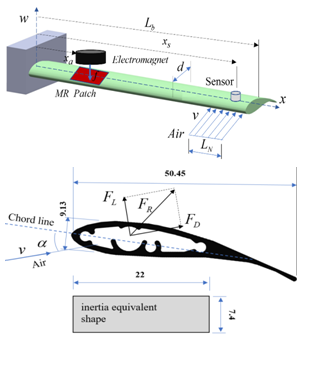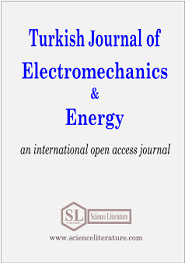
Active Vibration Suppression of a Flexible Blade Element Using Magnetorheological Layer Patch-Electromagnetic Actuator
Abstract
This study proposes a new active control structure to suppress vibrations of a small-scale wind turbine blade with magnetorheological fluid (MR) patch actuated by an electromagnet. An interaction model of the MR patch electromagnetic actuator was derived and a force characterization was realized. A linear quadratic gaussian (LQG) controller was designed using the state space model of the flexible blade element. The LQG controller was experimentally realized by means of the blade structure under the impact load and steady state aerodynamic load conditions. The results of experiments showed that the MR patch is effective for suppressing vibrations of the blade structure.
Full Text:
PDFReferences
G. Yang, Large-Scale magnetorheological fluid damper for vibration mitigation: modeling, testing and control, Ph.D. Dissertation, University of Notre Dame, (2001), http://cee.uiuc.edu/sstl/gyang2/ch2.pdf.
B. F. Spencer, S. Nagarajaiah, State of the art of structural control, Journal of Structural Engineering, 129, 845–856, (2003).
Y. L. Xu, W. L. Qu, and J. M. Ko, Seismic response control of frame structures using magnetorheological/electrorheological dampers, Earthquake Engineering and Structural Dynamics, 29, 557-575, (2000).
R. Stanway, J. L. Sproston, A. K. El Wahed, Applications of electrorheological fluids in vibration control: a survey, Smart Materials and Structures, 5, 464-482, (1996).
K. D. Weiss, J. D. Carlson, D. A. Nixon, Viscoelastic properties of magneto-and electro-rheological fluids, Journal of Intelligent Material Systems and Structures 5, 772-775, (1994).
H. Niu, Y. Zhang, X. Zhang, and S. Xie, Active vibration control of plates using electro-magnetic constrained layer damping, International Journal of Applied Electromagnetics and Mechanics, 33(1, 2), 831-837, (2010).
M. Romaszko, Free vibration control of a cantilever MR fluid based sandwich beam. In Carpathian Control Conference (ICCC), 2013 14th International (pp. 311-314), May, (2013).
B. Hu, D. Wang, P. Xia, & Shi, Investigation on the vibration characteristics of a sandwich beam with smart composites-MRF. World Journal of Modelling and Simulation, 2(3), 201-206, (2006).
L. Chen, & C. H. Hansen, Active vibration control of a magnetorheological sandwich beam, Proc. Acoustics 2005 (Busselton Western Australia), 93-98, (2005).
A. V. Valevate, Semi-active Vibration control of a beam using embedded magneto-rheological fluids, Doctoral Dissertation, Wright State University, (2004).
V. Rajamohan, R. Sedaghati, and S. Rakheja, Optimal vibration control of beams with total and partial MR-fluid treatments, Smart Materials and Structures, 20(11), 115016, (2011).
C. Hirunyapruk, Vibration control using an adaptive tuned magneto-rheological fluid vibration absorber, Doctoral Dissertation, University of Southampton, (2009).
S. A. Fazelzadeh, M. Azadi, and E. Azadi, Suppression of nonlinear aeroelastic vibration of a wing/store under gust effects using an adaptive-robust controller, Journal of Vibration and Control, 23(7), 1206-1217, (2017).
M. S. Selig, and B. D. McGranahan, Wind tunnel aerodynamic tests of six airfoils for use on small wind turbines. Journal of Solar Energy Engineering (Transactions of the ASME), 126(4), 986-1001, (2004).
D. M. Somers, and M. D. Maughmer, Theoretical aerodynamic analyses of six airfoils for use on small wind turbines, National Renewable Energy Laboratory (NREL), (No. NREL/SR-500-33295), (2003).
K. Zhou, and J. C. Doyle, Essentials of robust control upper saddle river, NJ: Prentice Hall, (104), 88-267, (1998).
URN: https://sloi.org/urn:sl:tjoee3163
Copyright (c) 2018 Turkish Journal of Electromechanics and Energy

This work is licensed under a Creative Commons Attribution-NonCommercial 4.0 International License.

 Indexed in:
Indexed in:
















